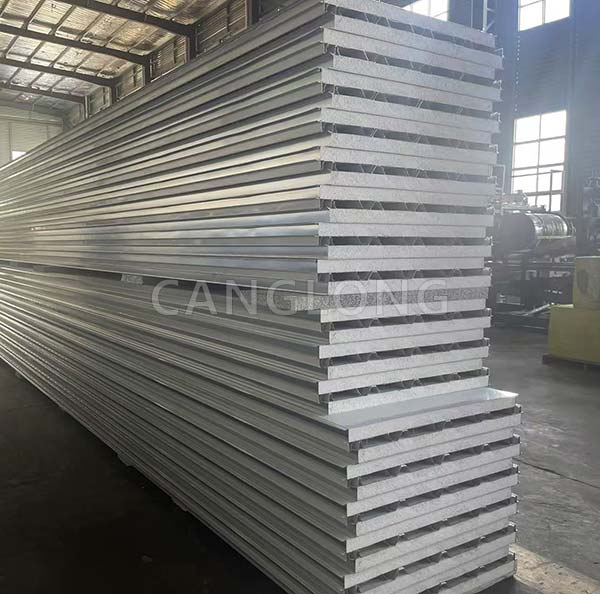Which buildings are suitable for eps roofing sheets?
Amidst global warming, fluctuating energy prices, and frequent extreme weather events, buildings, as major energy consumers in human activities, face unprecedented challenges. How can we insulate more efficiently? How can we reduce construction and maintenance costs? How can we recover faster from disasters? The answers to these questions may be hidden in a seemingly ordinary building material EPS roofing sheets.
This lightweight sheet, composed of a polystyrene core and a metal/cement surface, has quietly gained popularity in the global construction market in recent years. Its popularity is no accident; it precisely addresses several core needs in the current construction industry. Let’s analyze its application logic through architectural practices in different global scenarios.

1. High-Energy Consumption Regions
In regions with long, cold winters, such as Northern Europe, Canada, and Russia, building heating accounts for over 40% of total annual energy consumption. Keeping homes warm in winter and cool in summer is key to reducing carbon emissions and lowering residents’ expenses. The secret weapon of EPS roofing sheet is its extremely low thermal conductivity (approximately 0.033 W/(m·K)), equivalent to 1/20 that of traditional concrete roofs. It acts as an air lock, preventing heat loss from indoor spaces and blocking the ingress of cold temperatures. In a Norwegian community renovation project, homes equipped with eps roofing sheets reduced winter heating energy consumption by 35% compared to traditional ceramic tile roofs, saving residents over €2,000 in annual electricity bills.
EPS is also effective in the hot Middle East and Southeast Asia. It reflects some solar heat and, combined with ventilation, keeps indoor temperatures 5-8°C lower than bare concrete roofs. A commercial warehouse in Dubai, UAE, switched to EPS roofing sheets, reducing summer air conditioning run time by two hours per day and annual electricity consumption by 18%.
2. Disaster-Prone Regions
In recent years, with the increasing frequency of extreme weather events such as hurricanes, heavy rains, and hailstorms, the disaster resilience of buildings has become a global concern. The lightweight nature of eps roofing sheets (weighing only 8-15 kg per square meter) and its high impact resistance are ideal for meeting these challenges. In the typhoon-prone Philippines, the local government’s typhoon-resistant housing program includes EPS sandwich roof panels as standard. The bond strength between the metal surface sheet and the core material exceeds 3kPa, making it resistant to flying rocks from a Category 12 typhoon. Furthermore, the overall weight is only one-fifth that of a traditional concrete roof, significantly reducing the risk of collapse due to excessive weight.
In the Midwest of the United States, hailstorms cause over $1 billion in agricultural losses annually. A test in Kansas showed that a 10cm-thick EPS roofing sheet can withstand a 2-inch (approximately 5cm) diameter hailstone traveling at 80km/h without breaking, far outperforming ordinary tiles or color-coated steel sheets.
3. Rapidly Developing Regions
In rapidly urbanizing regions like Africa and South Asia, large populations require low-cost, easy-to-build housing and public facilities. Traditional brick-concrete or concrete roofs have a long construction period, high labor costs, and demanding transportation conditions (large trucks are required to transport steel and cement).
The modular design and lightweight nature of EPS roofing sheets make them ideal for these applications. A 3-meter-long EPS roofing sheet can be carried by two people and installed on-site with simple fixings. Its prefabrication also reduces pollution from on-site cutting and welding. In a slum renovation project in Nairobi, Kenya, the use of EPS roof panels reduced the construction time of a single-family home roof from 3 days to 6 hours, reducing material transportation costs by 40%.
Critically, EPS’s low cost does not sacrifice quality. Testing by the Indian Bureau of Standards shows that a compliant EPS sandwich roof panels can last over 25 years and has an 11-level wind resistance rating, fully meeting the needs of average local households.
4. Special-Function Buildings
Beyond residential and residential applications, EPS roofing sheets also offer unique value in industrial and public facilities. For example:
- Agricultural greenhouses: The EPS surface layer with optional light transmission (some models include a light strip), combined with an insulating core material, provides a stable temperature and humidity environment for the greenhouse, reducing winter lighting and heating costs.
- Temporary buildings: For quarantine shelters during the pandemic and temporary schools after disasters, EPS roofing sheets can be quickly assembled and disassembled, with a reusability rate exceeding 80%.
- Renovation of Old Buildings: Directly covering and installing overlays without demolishing the existing structure improves thermal insulation while preserving the building’s original character (a common application in the renovation of historic European districts).

Conclusion
From the cold of Northern Europe to the scorching heat of Southeast Asia, from typhoon-prone archipelagos to rapidly urbanizing Africa, the applicability of EPS roof panels stems from their precise response to the core contradictions of contemporary architecture: the need for energy conservation and carbon reduction, the pressure to respond to disasters, the urgency of affordable buildings, and the desire for diverse functionality.
EPS sandwich panels are not a universal material, but within their capabilities, they offer a more economical, flexible, and sustainable option for global architecture. When discussing green buildings and resilient cities, perhaps we can start with an EPS roofing sheets. In the simplest of ways, they connect human living needs with the future of the planet.
